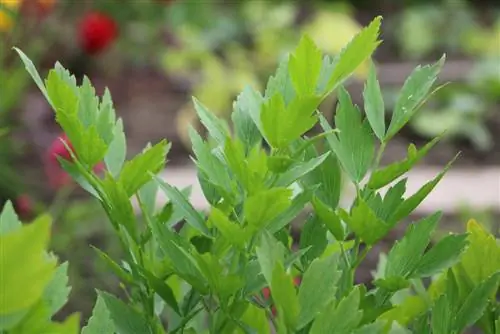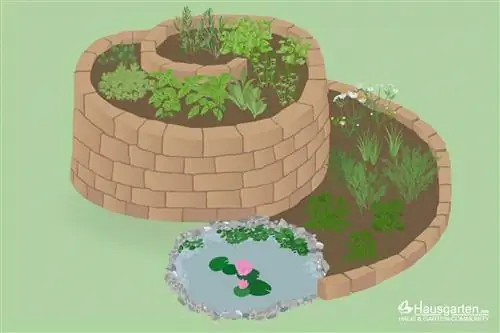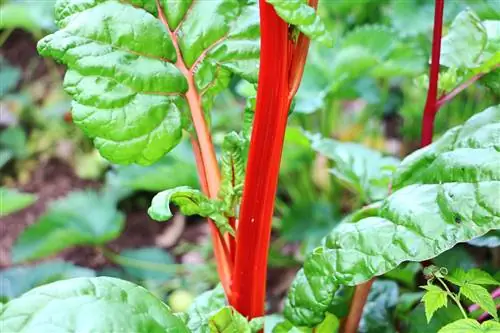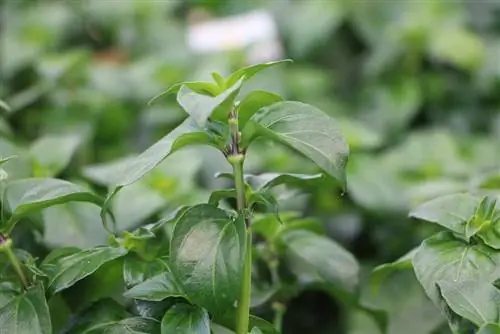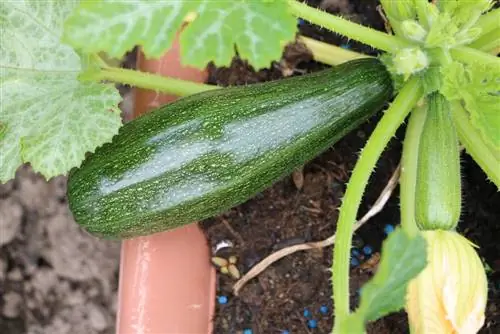- Author admin [email protected].
- Public 2023-12-17 03:39.
- Last modified 2025-06-01 06:48.
Growing, caring for and harvesting lovage is quite easy, even though the maggi herb is a heavy feeder. In order for the aromatic plant to thrive until it is used in the kitchen, a few points must of course be taken into account when cultivating it. From the right location to the suitable planting neighbors, the following explains what is important when it comes to care and how typical mistakes can be safely avoided, even without a green thumb.
Location
Light shade to full sun - lovage likes it bright and warm. When choosing a location, however, it should be noted that more sun also means a higher water requirement. So if you don't want to constantly reach for the watering can, you should choose light shade as a place to plant the maggi herb. When considering the location, it should also be taken into account that lovage not only has a strong taste, but also a strong aroma. This is exactly what can be assumed from the fruits of the plant neighbors. Berry bushes are particularly unfavorable due to the distorted taste. But almost all other plants also have their growth inhibited by the maggi herb.
Tip:
An otherwise unused corner, for example near the compost, or the culture in the bucket as far away as possible from other plants are sensible alternatives to the bed. Lovage is also suitable for suppressing weeds.
Substrate
The substrate for lovage should above all be nutrient-rich, because the herbaceous plant is a heavy feeder. Humous substrate that has a high pH value and is also permeable is ideal. The following points will help you find the optimal floor:
- Profound
- Relatively permeable but still retains water
- Calcareous with high pH
Fresh garden soil enriched with compost is well suited. Sand can be mixed in to loosen it up; to increase the water storage capacity, it is advisable to add clay or clay powder.
Tip:
Maggi herb basically grows in any soil, but a balanced mixture allows the herb to thrive better and also reduces the amount of care required.
Watering and fertilizing
Lovage likes it moist but not wet, which is why it appreciates watering as needed. Especially in summer, when temperatures are high, care should be taken to ensure that the substrate does not dry out. Although the maggi herb does not die, the lack of water is very quickly noticeable in the taste. To ensure that the watering effort is as low as possible and the substrate remains moist, a layer of mulch should be applied. This reduces evaporation and makes excessive watering unnecessary. Since the plant tolerates lime, hard tap water can also be used for watering. Stale tap water or pond water is still the better choice, otherwise too much lime can accumulate in the soil and roots.
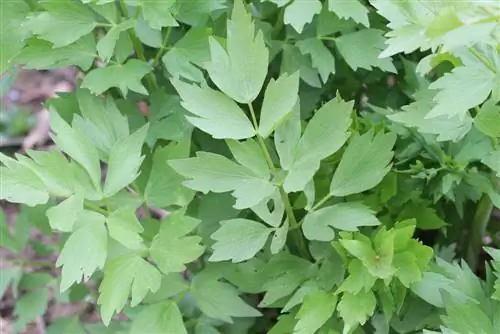
As already mentioned, Maggikraut is a heavy feeder. This meant that the lovage needed plenty of nutrients. Therefore, the substrate must be rich right from the start and fertilization must not be neglected. Suitable are:
- Untreated pond water
- Plant manure, for example from grass clippings or nettle
- Compost
- Herbal fertilizer
- Mulch
The bed is fertilized once a month during the growth phase, i.e. from around April to August. For example, if the soil was prepared with compost at the beginning of cultivation, additional nutrients may not be added during the first year.
Plants and cultivation
The cultivation of maggi herb can begin with direct sowing in the bed or by planting young plants. However, it should be noted that each plant is extremely productive and perennial. So the quantity should not be exaggerated. A well-developed lovage plant is usually sufficient for a family's consumption; it doesn't have to be a whole row. In order not to overuse one plant, two or three can of course be planted. Apart from a distance of around 40 centimeters from one another and, if possible, more open space to other plants, nothing needs to be taken into account. Knowing the following factors still helps:
- Deeply loosen up the substrate at the location
- Prepare the planting hole or planting site with compost
- Water abundantly after sowing or planting
- In the first few days, make sure the soil is always moist to accelerate growth
- When starting cultivation with seeds, water regularly until germination, then keep the soil moist and mulch
Blend
In the first few weeks and under the right conditions, lovage shows immense growth. Once the plant has reached a height of around 20 centimeters, a first cutting can be made. Only weaker side shoots that can already be used in the kitchen are removed. By removing the side shoots, more power goes into the strong main shoots and the maggi herb grows taller rapidly. A next trimming is recommended either in late autumn or early spring in order to remove the dead shoots and not to hinder the new growth. However, it is not really necessary to trim the lovage.
Harvest
The leaves and stems of the maggi herb are harvested and can be used fresh or dried. The harvest can begin when the first cutting is also possible. The spicy leaves of the lovage can be obtained during the entire growth phase, i.e. from spring to autumn.
Tip:
If you have never used fresh maggi herb, you should use it sparingly. The leaves are surprisingly productive and have a very strong taste.
Propagation
The propagation of the maggi herb is extremely easy by division, without any patience.
- The plant is dug up when it first shoots in spring.
- The root ball is removed from the soil and rinsed for cleaning.
- The root ball is divided in the middle with a clean spade, a knife or large scissors. The cutting tool should be disinfected if possible before it is used.
- The fresh cut surfaces can be dusted with a fungicide and left to air dry for a few hours.
- The resulting parts are then planted separately and watered well.
Stimulated by division, the maggi herb usually grows back very quickly. If you don't want to double your current population, you can also propagate the lovage from seeds. These are obtained from the fruiting bodies after the flower has matured, around September, and can be germinated at a temperature of around 20°C. As light germinators, the seeds should only be covered very thinly with substrate or simply pressed into it.
Wintering & culture in the bucket
During the winter, the lovage retreats into the roots, which spread very strongly and widely. Separate protection in the bed is therefore not necessary.
Culturing lovage in a bucket is possible without any problems if the container chosen has sufficient volume. It should be around 20 liters. The watering effort increases and fertilization should also be carried out every two weeks.
Typical care mistakes
Basically, you can't go wrong when growing lovage, as it is a very robust and adaptable plant. However, it should be noted:
- Keep substrate moist at all times
- Provide nutrient-rich soil
- Choose a sunny location
- Maintain a distance from other plants to avoid distorted taste and negative effects on growth
Conclusion
Maggikraut is a particularly easy-care and undemanding plant that can thrive in almost any place. Aromatic and flavorful in the kitchen, lovage can keep weeds under control in the garden by inhibiting the growth of other plants. Cultivation and harvesting are therefore correspondingly easy.

